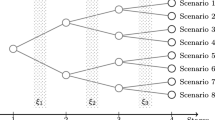Abstract
This paper describes a serial and parallel implementation of a hybrid stochastic dynamic programming and progressive hedging algorithm. Numerical experiments show good speedups in the parallel implementation. In spite of this, our hybrid algorithm has difficulties competing with a pure stochastic dynamic programming approach on a given test case from macroeconomic control theory.
Similar content being viewed by others
References
N.J. Berland, Load balancing in hypercubes solving stochastic optimization problems, ORSA Journal of Computing 7, 1995, 358–364.
D.P. Bertsekas and J.N. Tsitsiklis,Parallel and Distributed Computation. Numerical Methods, Prentice-Hall, Englewood Cliffs, NJ, 1989.
CHIMP Version 1.0 User Guide, Technical Report, EPCC, The University of Edinburgh, 1992.
R. Dornbush and S. Fischer,Macroeconomics, 5th ed., McGraw-Hill, Singapose, 1990.
T. Helgason and S.W. Wallace, Approximate scenario solutions in the progressive hedging algorithm, Annals of Operations Research 31, 1991, 425–445.
J.M. Mulvey and A. Ruszczyński, A new scenario decomposition method for large-scale stochastic optimization, Technical Report 91-19, Department of Civil Engineering and Operations Research, Princeton University, Princeton, NJ, May, 1991.
J.M. Mulvey and A. Ruszczyński, A parallel interior-point algorithm for large-scale stochastic optimization, Technical Report SOR-91-19, Department of Civil Engineering and Operations Research, Princeton University, Princeton, NJ, 1991.
J.M. Mulvey and H. Vladimirou, Solving multistage stochastic investment problems: An application of scenario aggregation, Technical Report SOR-88-1, Princeton University, Princeton, NJ, 1988.
J.M. Mulvey and H. Vladimirou, Evaluation of a parallel hedging algorithm for stochastic network programming, inImpact of Recent Computer Advances on Operations Research, R. Sharda, B.L. Golden, E. Wasil, O. Balci and W. Stewart, eds., North-Holland, New York, 1989, pp. 106–119.
J.M. Mulvey and H. Vladimirou, Parallel and distributed computing for stochastic network programming, Technical Report SOR-90-11, Department of Civil Engineering and Operations Research, Princeton University, Princeton, NJ, 1990.
R.T. Rockafellar and R.J-B Wets, Scenario and policy aggregation in optimization under uncertainty, Mathematics of OR 16, 1991, 1–29.
S.E. Wallace and T. Helgason, Structural properties of the progressive hedging algorithm, Annals of Operations Research 31, 1991, 445–457.
R.J-B Wets, Stochastic programs with fixed recourse: A basic theorem for multistage problems, Zeitschrift der Warscheinlichkeit und verwandter Gebiete 21, 1972, 201–206.
R.J-B Wets, The aggregation principle in scenario analysis and stochastic optimization, inAlgorithms and Model Formulations in Mathematical Programming, S.W. Wallace, ed., Springer, Berlin/Heidelberg, 1989, pp. 92–113.
S.A. Zenios (ed.),Financial Optimization, Cambridge University Press, Cambridge, UK, 1993.
Author information
Authors and Affiliations
Additional information
This research has been conducted with financial support from the Norwegian Research Council. As most of this work was conducted under the TRACS program at the University of Edinburgh, we want to thank Ken McKinnon and all other helpful people at the Department of Mathematics and Statistics of Edinburgh University and at the Edinburgh Parallel Computing Centre. We are also very grateful to our colleague Stein W. Wallace for his continuing support of our work. Without him, this research would probably never have taken place. We would also like to thank an anonymous referee for helpful corrections and comments.
Rights and permissions
About this article
Cite this article
Berland, N.J., Haugen, K.K. Mixing stochastic dynamic programming and scenario aggregation. Ann Oper Res 64, 1–19 (1996). https://doi.org/10.1007/BF02187638
Issue Date:
DOI: https://doi.org/10.1007/BF02187638




